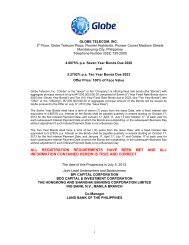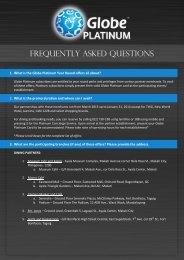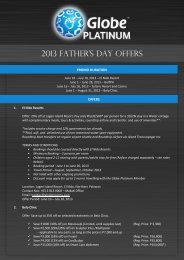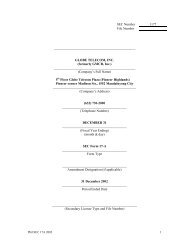here - Ayala
here - Ayala
here - Ayala
You also want an ePaper? Increase the reach of your titles
YUMPU automatically turns print PDFs into web optimized ePapers that Google loves.
Globe 2012 annual report<br />
financial report<br />
measured as the aggregate of the consideration transferred, measured at acquisition date fair value and the<br />
amount of any non-controlling interest in the acquiree. For each business combination, the Globe Group<br />
elects whether it measures the non-controlling interest in the acquiree either at fair value or at the<br />
proportionate share of the acquiree’s identifiable net assets. Acquisition costs incurred are expensed and<br />
included in administrative expenses.<br />
When the Globe Group acquires a business, it assesses the financial assets and financial liabilities<br />
assumed for appropriate classification and designation in accordance with the contractual terms, economic<br />
circumstances and pertinent conditions as at the acquisition date. This includes the separation of<br />
embedded derivatives in host contracts by the acquiree.<br />
If the business combination is achieved in stages, the acquisition date fair value of the acquirer’s previously<br />
held equity interest in the acquiree is remeasured to fair value at the acquisition date through profit or loss.<br />
Any contingent consideration to be transferred by the acquirer will be recognized at fair value at the<br />
acquisition date. Subsequent changes to the fair value of the contingent consideration that is deemed to be<br />
an asset or liability will be recognized in accordance with PAS 39 either in profit or loss or as a change to<br />
OCI. If the contingent consideration is classified as equity, it will not be remeasured. Subsequent<br />
settlement is accounted for within equity. In instances w<strong>here</strong> the contingent consideration does not fall<br />
within the scope of PAS 39, it is measured in accordance with the appropriate PFRS.<br />
Goodwill is initially measured at cost, being the excess of the aggregate of the consideration transferred<br />
and the amount recognized for non-controlling interest over the net identifiable assets acquired and<br />
liabilities assumed. If this consideration is lower than the fair value of the net assets of the subsidiary<br />
acquired, the difference is recognized in profit or loss.<br />
After initial recognition, goodwill is measured at cost less any accumulated impairment losses. For the<br />
purpose of impairment testing, goodwill acquired in a business combination is, from the acquisition date,<br />
allocated to each of the Globe Group’s cash-generating units (CGUs) that are expected to benefit from the<br />
combination, irrespective of whether other assets or liabilities of the acquiree are assigned to those units.<br />
W<strong>here</strong> goodwill forms part of a CGU and part of the operation within that unit is disposed of, the goodwill<br />
associated with the operation disposed of is included in the carrying amount of the operation when<br />
determining the gain or loss on disposal of the operation. Goodwill disposed of in this circumstance is<br />
measured based on the relative values of the operation disposed of and the portion of the CGU retained.<br />
2.7.12 Investments in Joint Ventures<br />
Investments in joint ventures (JV) classified as jointly controlled entities, are accounted for under the equity<br />
method, less any impairment losses. A JV is an entity, not being a subsidiary nor an associate, in which the<br />
Globe Group exercises joint control together with one or more venturers.<br />
Under the equity method, the investments in JV are carried in the consolidated statements of financial<br />
position at cost plus post-acquisition changes in the Globe Group’s share in net assets of the JV, less any<br />
allowance for impairment losses. The profit or loss includes Globe Group’s share in the results of<br />
operations of its JV. W<strong>here</strong> t<strong>here</strong> has been a change recognized directly in the JV’s equity, the Globe<br />
Group recognizes its share of any changes and discloses this, when applicable, in other OCI.<br />
2.7.13 Impairment of Nonfinancial Assets<br />
For nonfinancial assets, excluding goodwill, an assessment is made at the end of the reporting date to<br />
determine whether t<strong>here</strong> is any indication that an asset may be impaired, or whether t<strong>here</strong> is any indication<br />
that an impairment loss previously recognized for an asset in prior periods may no longer exist or may have<br />
decreased. If any such indication exists and when the carrying value of an asset exceeds its estimated<br />
recoverable amount, the asset or CGU to which the asset belongs is written down to its recoverable<br />
amount. The recoverable amount of an asset is the greater of its net selling price and value in use.<br />
Recoverable amounts are estimated for individual assets or investments or, if it is not possible, for the CGU<br />
to which the asset belongs. For impairment loss on specific assets or investments, the recoverable amount<br />
represents the net selling price.<br />
In assessing value in use, the estimated future cash flows are discounted to their present value using a pretax<br />
discount rate that reflects current market assessments of the time value of money and the risks specific<br />
to the asset.<br />
An impairment loss is recognized only if the carrying amount of an asset exceeds its recoverable amount.<br />
An impairment loss is charged against operations in the year in which it arises. A previously recognized<br />
impairment loss is reversed only if t<strong>here</strong> has been a change in estimate used to determine the recoverable<br />
amount of an asset, however, not to an amount higher than the carrying amount that would have been<br />
determined (net of any accumulated depreciation and amortization for property and equipment, investment<br />
property and intangible assets) had no impairment loss been recognized for the asset in prior years. A<br />
reversal of an impairment loss is credited to current operations.<br />
For assessing impairment of goodwill, a test for impairment is performed annually and when circumstances<br />
indicate that the carrying value may be impaired. Impairment is determined for goodwill by assessing the<br />
recoverable amount of each CGU (or group of CGUs) to which the goodwill relates. W<strong>here</strong> the recoverable<br />
amount of the CGU is less than their carrying amount, an impairment loss is recognized. Impairment losses<br />
relating to goodwill cannot be reversed in future periods.<br />
2.7.14 Income Tax<br />
2.7.14.1 Current Tax<br />
Current tax assets and liabilities for the current and prior periods are measured at the amount expected<br />
to be recovered from or paid to the tax authority. The tax rates and tax laws used to compute the<br />
amount are those that are enacted or substantively enacted as at the end of the reporting date.<br />
2.7.14.2 Deferred Income Tax<br />
Deferred income tax is provided using the balance sheet liability method on all temporary differences,<br />
with certain exceptions, at the end of the reporting date between the tax bases of assets and liabilities<br />
and their carrying amounts for financial reporting purposes.<br />
Deferred income tax liabilities are recognized for all taxable temporary differences, with certain<br />
exceptions. Deferred income tax assets are recognized for all deductible temporary differences, with<br />
certain exceptions, and carryforward benefits of unused tax credits from excess minimum corporate<br />
income tax (MCIT) over regular corporate income tax (RCIT) and net operating loss carryover<br />
(NOLCO) to the extent that it is probable that taxable income will be available against which the<br />
deductible temporary differences and the carryforward benefits of unused MCIT and NOLCO can be<br />
used.<br />
Deferred income tax is not recognized when it arises from the initial recognition of an asset or liability in<br />
a transaction that is not a business combination and, at the time of transaction, affects neither the<br />
accounting income nor taxable income or loss. Deferred income tax liabilities are not provided on<br />
nontaxable temporary differences associated with investments in JV.<br />
Deferred income tax relating to items recognized directly in equity or OCI is included in the related<br />
equity or OCI account and not in profit or loss.<br />
The carrying amounts of deferred income tax assets are reviewed every end of reporting date and<br />
reduced to the extent that it is no longer probable that sufficient taxable income will be available to<br />
allow all or part of the deferred income tax assets to be utilized.<br />
Deferred income tax assets and liabilities are offset, if a legally enforceable right exists to set off<br />
current income tax assets against current income tax liabilities and the deferred income taxes relate to<br />
the same taxable entity and the same taxation authority.<br />
Deferred income tax assets and liabilities are measured at the tax rates that are expected to apply in<br />
the year when the assets are realized or the liabilities are settled based on tax rates (and tax laws) that<br />
have been enacted or substantively enacted as at the end of the reporting date.<br />
Movements in the deferred income tax assets and liabilities arising from changes in tax rates are<br />
charged or credited to income for the period.<br />
2.7.15 Provisions<br />
Provisions are recognized when: (a) the Globe Group has a present obligation (legal or constructive) as a<br />
result of a past event; (b) it is probable (i.e., more likely than not) that an outflow of resources embodying<br />
economic benefits will be required to settle the obligation; and (c) a reliable estimate can be made of the<br />
amount of the obligation. Provisions are reviewed every end of the reporting period and adjusted to reflect<br />
the current best estimate. If the effect of the time value of money is material, provisions are determined by<br />
discounting the expected future cash flows at a pre-tax rate that reflects current market assessment of the<br />
time value of money and, w<strong>here</strong> appropriate, the risks specific to the liability. W<strong>here</strong> discounting is used,<br />
the increase in the provision due to the passage of time is recognized as interest expense under “Financing<br />
costs” in consolidated statements of comprehensive income.<br />
158 159
















